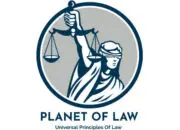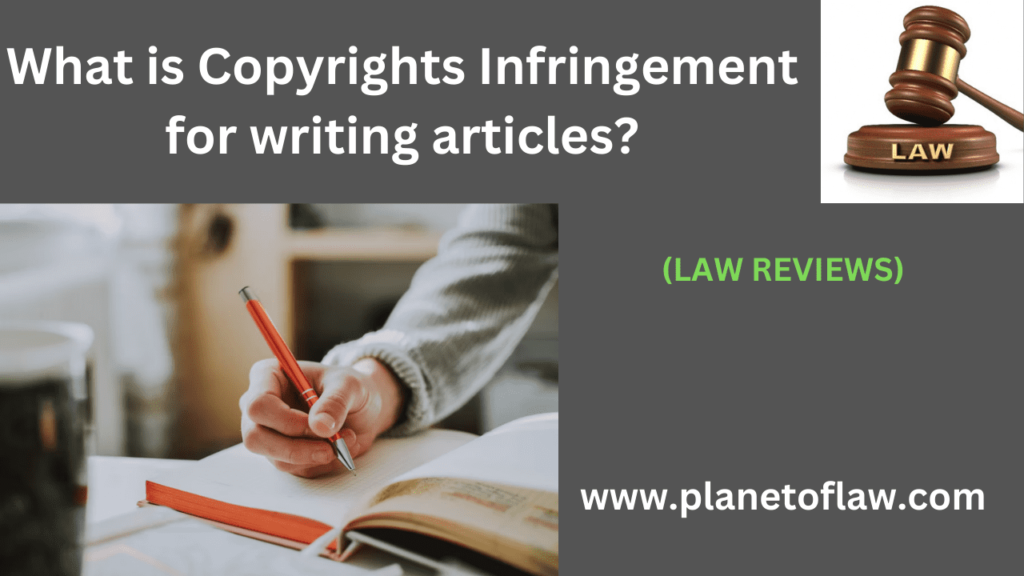Introduction –
What is Copyrights Infringement for writing articles?
Copyright infringement in the context of writing articles occurs when someone reproduces, distributes, displays, or creates derivative works based on an original article without the permission of the copyright owner. In most countries, copyright protection is automatic upon the creation of the work, and it grants the creator exclusive rights to their work for a specified period.
Here’s how copyright infringement may apply to writing articles:
- Reproduction: If someone copies an entire article or a substantial portion of it without permission, it may constitute copyright infringement.
- Distribution: Sharing or distributing copies of an article without authorization from the copyright owner can be considered infringement.
- Public Display: If someone publicly displays an article without permission, it could violate the copyright owner’s rights.
- Derivative Works: Creating new works based on the original article, such as adaptations, translations, or other modifications, without the copyright owner’s permission may also lead to infringement.
It’s important to note that there are limitations to copyright, such as fair use or fair dealing provisions, which may allow for the use of copyrighted material under specific circumstances, such as for criticism, commentary, news reporting, education, or research. However, these exceptions vary by jurisdiction.
To protect your articles from copyright infringement, you can consider taking steps like clearly stating your copyright information, licensing your work, and monitoring for unauthorized use. If you discover that someone has infringed upon your copyright, you may take legal action to enforce your rights. Consulting with a legal professional specializing in intellectual property law is advisable for specific guidance based on your situation and local regulations.
How to copyright wrting articles in India?
In India, the moment you create an original work, including writing articles, it is automatically protected by copyright law. However, to establish and enforce your rights more effectively, you can take the following steps:
- Use a Copyright Notice:
- Although not mandatory, placing a copyright notice on your articles can serve as a deterrent and make it clear that the work is protected. Include the symbol ©, the year of first publication, and your name (e.g., © 2024 Your Name).
- Keep Records:
- Maintain records that can help establish your authorship and the date of creation. This could include drafts, emails, or any other documentation showing the development of your articles.
- Register Your Work:
- While copyright protection is automatic, registering your articles with the Copyright Office provides additional benefits. It creates a public record of your copyright and can be useful in legal proceedings.
- To register, you can submit an application along with a copy of your work to the Copyright Office. In India, the copyright registration process is managed by the Copyright Office of the Department of Promotion of Industry and Internal Trade (DPIIT).
- Licensing:
- Consider licensing your articles to others. This allows you to specify how others can use your work, and it can help clarify the terms under which others may use or reproduce your articles.
- Monitor and Enforce:
- Regularly monitor online platforms and publications to ensure that your articles are not being used without your permission.
- If you discover copyright infringement, you may need to take legal action. Consulting with a legal professional specializing in intellectual property law in India can guide you through the enforcement process.
Remember that the copyright protection in India is governed by the Copyright Act, and it’s advisable to stay informed about any changes in the law. If you have specific legal concerns or questions, consulting with a legal professional in India is recommended for personalized advice.
What are the types of copyright for writing articles?
When it comes to writing articles, the copyright holder typically has the exclusive rights to reproduce, distribute, display, and create derivative works based on the original content. There aren’t distinct “types” of copyright for different forms of writing; instead, copyright protection applies broadly to various types of creative works, including articles. Here are some key aspects related to copyright for writing articles:
- Automatic Copyright:
- Copyright protection is generally automatic upon the creation of an original work, such as writing an article. Registration is not required for copyright to exist, but it can offer additional legal benefits.
- Exclusive Rights:
- The copyright holder has exclusive rights to reproduce the article, distribute copies, publicly display the work, and create derivative works based on it.
- Moral Rights:
- Some jurisdictions, including India, recognize moral rights alongside economic rights. Moral rights include the right to be attributed as the author and the right to object to derogatory treatment of the work.
- Duration of Copyright:
- The duration of copyright protection varies by jurisdiction but typically lasts for the life of the author plus a certain number of years. In India, the duration is the lifetime of the author plus 60 years.
- Fair Use or Fair Dealing:
- Many copyright laws include provisions for “fair use” or “fair dealing,” allowing limited use of copyrighted material without permission for purposes such as criticism, commentary, news reporting, education, or research.
- Creative Commons Licenses:
- Authors can choose to license their articles under Creative Commons licenses. These licenses provide a standardized way for authors to grant permissions for others to use their work under certain conditions.
- Work for Hire:
- In some cases, if an article is created as part of employment or under a contract specifying “work for hire,” the employer or the contracting party may be considered the copyright owner.
- Public Domain:
- Works in the public domain are not protected by copyright and can be freely used by the public. Copyright protection expires over time, eventually placing works in the public domain.
Understanding these aspects can help authors navigate the legal framework surrounding their articles and make informed decisions about how to protect and share their work. Keep in mind that copyright laws may vary by jurisdiction, so it’s essential to be aware of the specific regulations in your country.

